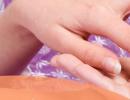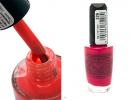Heat treatment and vitamins: how high temperature affects. Thermal effect on vitamin C - interesting findings Vitamin K remains during heat treatment
Changes in vitamins in fruits and vegetables
Carotenoids are stable and their amount remains virtually unchanged during heat treatment. There are very few B vitamins in plant products and during hydrothermal treatment they turn into a decoction and are destroyed slightly.
Vitamin PP is not destroyed by boiling, exposure to oxidizing agents and light. It is one of the most stable vitamins.
For an animal organism, three substances are equivalent in biological action: pyridoxine, pyridoxal and pyridoxamine. All three compounds with the biological activity of vitamin B6 are resistant to heat, unstable to the action of oxidizing agents, such as peroxides, and also matchmaker.
Pantothenic acid is resistant to atmospheric oxygen at room temperature and is destroyed by autoclaving and heating in acidic to alkaline solutions.
Biotin is resistant to heat and dilute acids and alkalis. Prolonged aeration and H2O2 do not affect its activity.
Choline is a colorless, syrupy, alkaline substance that is resistant to heat.
The greatest degree of destruction is observed in vitamin B6: when spinach is cooked, it decreases by 40%; white cabbage by 36%; carrots by 22%.
When heating aqueous solutions, vitamin B12 is most stable at pH 7; at pH 2, a slow loss of activity occurs, and at pH 9, rapid destruction occurs. Autoclaving this vitamin at 121°C in a neutral environment for 15 minutes does not change its activity. It is destroyed in solutions under the influence of light.
Vitamin A and carotene, due to the presence of a large number of double bonds, are highly reactive. They are unstable to heat in the presence of oxygen, but stable in its absence. Vitamin A in the absence of oxygen can be heated to 120-130° C without changing the chemical structure and loss of biological activity; it is destroyed by exposure to ultraviolet rays.
Vitamin D is resistant to high temperatures, as well as oxygen, but when heated no higher than 100° C.
Tocopherols are resistant to heating up to 200° C in the presence of oxygen; are destroyed by ultraviolet rays and some oxidizing agents.
Vitamin K is resistant to high temperatures, except for heating in an alkaline environment. Destroyed by ultraviolet rays.
Vitamin C undergoes significant changes. Ascorbic acid is oxidized by atmospheric oxygen under the action of an enzyme and becomes dehydroascorbic acid. With further heating, both forms are destroyed. The rate of destruction of ascorbic acid depends on the properties of the processed semi-finished product, heating rate, duration of processing, contact with atmospheric oxygen, composition and pH of the medium. The higher the vitamin C content and the lower the dehydroascorbic acid content, the less it is destroyed. The faster the heating, the better vitamin C is preserved, and the faster the enzyme that oxidizes vitamin C is inactivated. The presence of oxygen, copper, iron, and manganese in the cooking medium reduces the amount of vitamin C.
In an acidic environment, vitamin C is destroyed less. When vegetables are cooked in an acidic environment (tomato paste), vitamin C is preserved better (due to the weakening of the effect of copper ions).
Copper, iron, and magnesium ions contained in tap water or entering the cooking medium from the walls of the cookware catalyze the destruction of vitamin C.
Substances contained in vegetables and fruits (amino acids, vitamin A, E, thiamine, anthocyanins, carotenoids) prevent the destruction of vitamin C. Cooking in broth preserves vitamin C.
Storing foods in a hot state at room temperature destroys vitamin C. The greatest loss of vitamin C occurs during poaching. When frying, it is destroyed less than during hydrothermal treatment because there is less access to oxygen, rapid heating, and a short period of thermal exposure. When making products from vegetable cutlet mass, up to 90% of vitamin C is destroyed.
Cutting vegetables and fruits increases the destruction of vitamin C.
The name “ascorbic acid” reflects the fact that this substance prevents the development of scurvy (a + scorbutus).
History of discovery
The need for fresh plant food to maintain health has been noted since time immemorial, but the honor of scientifically substantiating good nutrition in the prevention and treatment of scurvy belongs to the British ship surgeon James Lind, who in 1747 proved that scurvy is prevented by the inclusion of citrus fruits in the diet. Ascorbic acid was isolated and identified as an individual substance in 1928-1933 by a group of American researchers led by Albert Szent-Györgyi, who received the Nobel Prize in Medicine in 1937 for this work. Already in 1934, a route for the chemical synthesis of vitamin C was developed and its mass production began.
Chemical nature
Ascorbic acid is a derivative of glucose in its furanose form (with a 5-membered ring). Of the two spatial isomers, only the L-form has biological activity. In natural sources, ascorbic acid is in the active L-form, while chemical synthesis produces a racemate - a mixture of equal amounts of L and D forms.
The ascorbic acid molecule easily gives up electrons to other organic molecules, turning into an oxidized form - dehydroascorbic acid. This reaction is reversible in the body.
Ascorbic acid is a colorless crystalline water-soluble substance with a sour taste and exhibits the properties of a reducing agent. It easily oxidizes and decomposes under the influence of oxygen, light and in contact with metals, so its preparations are stored in a cool, dark place in non-metallic containers.
Biological role
Vitamin C plays the role of an antioxidant in the body, neutralizing free radicals. As an electron donor, vitamin C takes part in the biosynthesis of a number of important biological compounds. Vitamin C is a cofactor for enzyme systems for the biosynthesis of collagen (part of the walls of blood vessels), carnitine (responsible for the transport of fatty acids into mitochondria, which is critical for the synthesis of ATP), for enzymes in the synthesis and regulation of the activity of peptide hormones and a number of others. Tissues with an increased level of metabolism require large amounts of vitamin C. Its concentration in the brain, lungs, spleen, liver, secretory glands is 10...50 times higher than the concentration in blood plasma, and in the thymus and retina - more than 100 times.
Both plants and most animals synthesize vitamin C from glucose and do not require additional sources. The process takes place in four stages and, accordingly, requires the work of four enzymes. Humans, higher primates, guinea pigs and fruit-eating bats have lost this ability in the process of evolution due to a defect in the gene responsible for the synthesis of L-gulonolactone oxidase, the enzyme responsible for the final stage of vitamin C synthesis. The mutation is not lethal, since all of these animal species are Get enough vitamin C from plant foods. Interestingly, the loss of the ability of the human body to synthesize vitamin C is partly compensated for by the increased efficiency of its absorption. The body of an adult goat, for example, normally synthesizes approximately 13 g of vitamin C per day, which is two orders of magnitude higher than the daily requirement of an adult human body.
Like all water-soluble vitamins, vitamin C is not stored in the body as a reserve. Undigested excess is excreted in urine and other physiological fluids. Half of the vitamin C that enters the body is eliminated from it after 16 days, so when it stops entering the body, symptoms of vitamin C deficiency appear quite quickly.
Vitamin C is absorbed in the intestines through channels controlled by sodium ions. High concentrations of sugar in the intestines or blood impair its absorption.
Sources
An exceptionally rich source of vitamin C is rose hips. The fruits of high-vitamin rose hips contain an average of 2% vitamin C (2000 mg%). For comparison, black currants contain 200 mg%, lemons - 40 mg%, and apples only 6 mg% of vitamin C.
The highest content of vitamin C in animal food is in the liver (10...25 mg% depending on the method of preparation); there is practically no vitamin C in meat.
Contrary to popular belief, vitamin C is not destroyed in boiling water: the ascorbic acid molecule decomposes at a temperature of 190°C. Pressure cooking, and especially frying, can, however, significantly reduce the vitamin C content of the finished product, as can cooking in copper cookware. Copper catalyzes the breakdown of ascorbic acid.
A significant portion of vitamin C in developed countries is consumed by the population in the form of vitamin preparations and dietary supplements.
Daily requirement
Western medicine's recommended daily intake of vitamin C is 90 mg for adult men and 75 mg for women. The maximum permissible dosage is up to 2000 mg/day. A number of Western scientists and medical practitioners, including Nobel laureate Linus Pauling, advocate for revising the daily intake to 2-3 grams per day, based on the content of vitamin C in the blood serum of mammals and its estimated content in the diet of great apes.
Vitamin C deficiency
An acute lack of vitamin C is a force majeure phenomenon: the native population of the North compensates for the lack of plant foods by eating meat that has undergone minimal heat treatment. A balanced diet fully meets the vitamin C needs of a healthy body, but pregnancy, chronic stress and smoking, as well as poor nutrition in the winter and spring can lead to hypovitaminosis. The need for vitamin C increases sharply during recovery from injuries, as well as during illness. The idea of megavitamin therapy is based on this fact - taking loading doses of vitamin C to treat a wide range of diseases.
You can rejoice a hundred times over the generous vitamin composition of a particular product and anticipate the beneficial effects of consuming various foods. It’s just important not to forget that vitamins are not so permanent - they are subject to destruction. Some vitamins are destroyed by temperature, others by sunlight, and others are affected by some third factors. You need to know and remember this!
How do vitamins tolerate heat treatment?
Vitamin A. Contained in liver, garlic, butter, broccoli, seaweed, carrots, tomatoes, green onions and dill. Heat treatment destroys up to 30% of its biological properties.
Vitamin A is destroyed especially intensively during frying and drying under the influence of ultraviolet rays. It is well preserved when products are sterilized at temperatures up to 120 degrees.
Vitamin B1. Contained in oatmeal, millet, pork, liver, buckwheat, and pasta. Particularly sensitive to cooking (loses up to 45% of benefits), frying (up to 42%) and stewing (up to 30%). Loses activity at temperatures above 120 degrees.
Vitamin B2. Contained in liver, mushrooms, chicken eggs, goose. If you cook the listed products, you will lose up to 43% of the beneficial properties, so other cooking methods are preferable (when stewing, only 10% of the biological activity of the vitamin is lost).
Vitamin B6. Contained in beans, tuna, mackerel, sweet peppers, chicken, spinach, and white cabbage. This vitamin is truly resistant to high temperatures, and boiling the listed products is even beneficial, since this way B6 releases its active components.
Vitamin B9. Contained in liver, beans, spinach, broccoli, barley, porcini mushrooms and champignons. Does not tolerate any heat treatment well, losing up to 90% of its properties. The loss of this vitamin during cooking and preservation is especially significant.
Vitamin C. Contained in rose hips, sweet peppers, cabbage, oranges, lemons, garlic, spinach. It’s not for nothing that these products are most often eaten fresh: by boiling cabbage, we lose up to 90% of the vitamin, and stewing destroys it by 50%. Each subsequent heat treatment of a finished dish reduces the vitamin C content in it by 30%.
Vitamin D. Contained in sea bass, liver, chicken eggs, butter. It tolerates heat treatment well if the temperature does not exceed 100 degrees. It is destroyed largely due to exposure to oxygen, so it can easily withstand the sterilization of products.
Vitamin E. Contained in rose hips, salmon, pike perch, wheat, dried apricots, prunes, oatmeal and barley. It is practically not destroyed under the influence of high temperature, but suffers from direct sunlight.
Vitamin PP. Contained in poultry, rabbit, beef, fish and liver. It tolerates any heat treatment, canning and freezing. The listed products will lose from 5 to 40% of the beneficial properties of the vitamin, no matter how they are prepared.
In order not to lose all the vitamins during cooking, control the temperature: it should not exceed 100 degrees. This will destroy pathogenic microorganisms, but will preserve the biological properties of the products.
The heat treatment time should be reduced as much as possible. Steam or bake vegetables. Do not chop them too finely, do not use a grater or blender. It is optimal if the products are cleaned and cut before use.
For better perception and ease of understanding which factors negatively affect different vitamins, see the table.
| Vitamin | Destructive factor | Additional information | |||
| Water | Air | Light | Heat | ||
| Cooking takes about 30% of retinol from products, and alcohol and high temperatures completely destroy it. Relatively resistant to light and air influences. | |||||
| D | Medium resistance to atmospheric oxygen. At temperatures above 100°C, destruction processes begin, 200°C is a critical figure. | ||||
| E | Sun rays and prolonged heat treatment above 170°C actively destroy it. There is poor resistance to freezing and long-term storage. | ||||
| C | Any physical and chemical influences negatively affect the presence of this vitamin in products. It is destroyed even during normal short-term storage. | ||||
| B1 | Thiamine (B1) quickly dissolves in water and loses its properties. Destroys when heated above 100°C. The influence of direct sunlight has not been established. | ||||
| B2 | Riboflavin (B2) is slowly destroyed in water. It is stable in an acidic environment, but not stable in an alkaline environment. The effect of light on this vitamin has not been established. | ||||
| B3 | Nicotinic acid, vitamin PP, niacin are all aliases for B3. It dissolves quickly in hot water. Alcohol also actively destroys this vitamin. | ||||
| B5 | Pantothenic acid (B5) slowly loses its properties in water, and heat and alcohol actively destroy this vitamin. The influence of air and light has not been established. | ||||
| B6 | Pyridoxine (B6) quickly dissolves in water, is not resistant to sunlight and is destroyed rather slowly during heat treatment. Resistant to oxygen. | ||||
| B9 | Folic acid (B9) is destroyed quite quickly under any type of physical and chemical influence. Loses its properties even during long-term storage. | ||||
| B12 | Cobalamin (B12) is susceptible to the negative effects of water, alcohol, and direct sunlight. Destroys on contact with copper or iron. Resistant to heat. | ||||
| TO | Phylloquinone or prenylmenaquinone (K) is poorly resistant to heat treatment and is quickly destroyed when exposed to direct sunlight. | ||||
Scientific research has proven that the human body receives about 90-95 percent of the total amount of vitamins through a balanced diet. The relevant question is at what temperature vitamin C is destroyed; it most often arises during colds due to the need to strengthen the immune system and effectively fight viruses.
Ascorbic acid is an important factor in health and well-being
This powerful antioxidant not only regulates redox reactions, but also normalizes blood clotting and capillary permeability, and has anti-allergic and anti-inflammatory effects.
Vitamin C plays an important role in the synthesis of collagen, catecholamines and steroid hormones. In addition, it regulates metabolic processes associated with calcium, iron and folic acid, improving their absorption. This vitamin is the most important factor in protecting the body from stress and its consequences. Therefore, the question of under what conditions and at what temperature vitamin C is destroyed worries almost everyone, including residents of megacities, remote cities and rural settlements.
The main reasons for the destruction of vitamin C
Heat treatment of most products has a beneficial effect on their quality: it improves taste, softens the structure, and destroys harmful microbes and toxins. Boiled, stewed, baked, steamed and even fried foods are much safer than raw foods. It can protect a person from digestive problems (intestinal disorders and disruption of the pancreas). But what temperature destroys vitamin C, which is so necessary for the human body? And what other factors influence destructive processes in ascorbic acid?
Water-soluble vitamin C is an unstable compound that can decompose even during long-term storage and reacts negatively to any chemical and physical influences. Ascorbic acid is easily oxidized. Its preparations cannot be stored in metal containers, since the acid reacts upon contact with the container. Vitamin C should also not be exposed to light, heat, high air humidity, or contact with oxygen, which contributes to its destruction. The presence of this vitamin in products decreases at any ambient temperature, but to varying degrees.
What does science say?
The ascorbic acid molecule, according to a number of researchers, is completely destroyed at a temperature of 191-192 °F (88-89 °C), but only one isomer (L-ascorbic acid), or vitamin C, is biologically active, a natural substance that found in vegetables and fruits. Its quantity is influenced by the duration of transportation and shelf life of products, their protection from air and light and other parameters.
After purchasing vegetables or fruits, it matters whether they are stored in the refrigerator or not, whole or chopped, how long they are cooked and at what temperature. Vitamin C is destroyed at a threshold of 60-70 degrees, but is stable in an acidic environment. Salads (cold and hot) with lemon juice, main courses with the addition of tomatoes or tomato paste retain this vitamin much better than first courses with a high liquid content, but do not have acidic ingredients. Drying, cutting, heating food for a long time in a pan with an open lid, reheating food, copper or iron utensils actively destroy a powerful antioxidant.
Experiment with the “correct” water and express rosehip infusion
Using distilled water instead of tap water helps significantly preserve vitamin C when boiled briefly. An American chemistry student conducted an experiment: in one cup of distillate he dissolved 1 teaspoon of ascorbic acid to obtain its concentration of 2-25%. As a result, the measuring device showed 217%. The researcher tightly covered the container with the solution with thermal film and left a small hole to release steam. Briefly heat the cup with ascorbic acid (no more than 2 minutes) in the microwave, then cool it for 5 minutes and put it in the refrigerator. After 75 minutes, when the solution had cooled to room temperature, he again measured the concentration of vitamin C. Due to short-term evaporation, this figure increased to 219%! For the same purpose, experts advise preparing express infusions of berries rich in vitamin C.
The maximum amount of this vitamin is guaranteed to be preserved if you quickly chop the rose hips, pour boiled water over them at a temperature of no higher than 40-60 degrees, and then leave for an hour in a tightly closed thermos. Prolonged boiling of rose hips destroys L-ascorbic acid, significantly reducing the value of the decoction compared to freshly squeezed juices and express infusions.
Hot tea and boiling lemon infusion
On forums you can often come across a question from hot tea lovers at what temperature vitamin C is destroyed. Japanese researchers, contrary to the widespread belief that this popular drink should not be brewed with boiling water, have proven that the L-isomer of ascorbic acid (vitamin C) is only slightly destroyed. . Its concentration in the first quarter of an hour drops by only 30 percent in brewed tea at a constantly maintained boiling temperature, but after an hour it disintegrates almost completely. At the same time, in ordinary boiling water, dissolved vitamin C is destroyed by 83 percent after just 10 minutes.
Experts explain this difference by the fact that tea phenol reacts with copper and iron ions, binding them, which prevents their influence on accelerating the breakdown of vitamin C. If you need to prepare hot lemonade with 6 lemons, then cut them in half and throw them into boiling water . After just 3 minutes, remove the container from the stove and infuse the drink for 10-15 minutes. Then it is filtered from the fruits and pulp. This lemonade protects against colds and improves immunity if you drink it hot or warm, adding a little honey. Store the drink in the refrigerator and heat it in the microwave to maximize the preservation of ascorbic acid.
When preparing first and second courses
There is no exact data that indicates at what temperature vitamin C is destroyed in each specific dish. It is known that already at 50 degrees Celsius in potato soup the concentration of ascorbic acid will begin to decrease if you do not cover the pan with a lid and add vegetables earlier than expected. According to the rules, they must be added to boiling salted water, and the dishes must be covered with a lid during cooking. The same should be done with frozen vegetables, because boiling water contains much less dissolved oxygen, which destroys vitamin C. In addition, the high boiling temperature activates, next to ascorbic oxidase, other beneficial plant enzymes that contribute to better preservation of the vitamin. For potatoes, poured with boiling water and boiled in their skins, their quantity decreases by about 10 percent. Less water also prevents the natural ascorbic acid from breaking down.
For example, sauerkraut cabbage soup after cooking for an hour loses 50% of its powerful antioxidant, and stewed cabbage loses only 15%. Tomatoes cooked for 2 minutes in a microwave or oven (at 90 degrees) lose only 10 percent of the vital substance. The same tomatoes, cooked for half an hour, lose about 29-30% of vitamin C. Steamed vegetables get rid of 22-34% of the valuable vitamin, and in a microwave oven - 10% in the same period of time.
At what temperature is vitamin C destroyed in cherry plum?
The benefits of this well-known plum are especially noticeable during the cold season. Its diaphoretic and antitussive effect is valued along with its pleasant taste and many other healing properties. Tkemali, as “cherry plum” is called in the Caucasus and Transcaucasia, contains some sugars, but it contains citric and malic acids, vitamins B, A, E and PP. Cherry plum is rich in pectin, calcium, magnesium, sodium, iron, phosphorus. In addition, it is a real source of vitamin C. The temperature of its destruction also depends on all the factors described above. For example, cherry plum compote will contain much less of this valuable substance than tkemali sauce, because in a large amount of water the described vitamin is destroyed faster than in a seasoning without additional liquid. Cherry plum is a powerful source of ascorbic acid also because other acids in its fruits prevent the breakdown of the water-soluble vitamin.
Reaction of other useful elements to heat
Doctors consider vitamin D to be the second, no less important “anti-cold vitamin,” which is recommended to be taken along with rosehip infusion. Fish oil, vegetable oils and cheese should be on every table during the off-season. At what temperature is vitamin D destroyed? During heat treatment, fat-soluble vitamins (A, D, E, K) practically do not reduce their activity and are not destroyed. At the same time, vitamin D can withstand prolonged boiling in an acidic environment, but is prone to rapid destruction in an alkaline environment. It is known that at a temperature of +232 degrees in the oven, cheese loses up to 25-30% of the “anti-cold” vitamin within 5 minutes. It is known that rose hips, in addition to vitamin C, contain vitamin P (rutin). This substance enhances the effect of ascorbic acid, and their combined use is necessary when prescribing aspirin with sulfonamides for a full, restorative effect on the capillaries. The answer to the question at what temperature vitamin P is destroyed is similar to the recommendations regarding ascorbic acid. These two vitamins are identical in many ways: both are water-soluble, resistant to sunlight, exposure to oxygen and the same temperature. In addition to rose hips, rutin is found in lemons. Complementing and reinforcing each other, these vitamins are also indicated for long-term antibiotic therapy.
MOSCOW, October 14 - RIA Novosti, Olga Kolentsova. The role of proteins, fats and carbohydrates in the body is clear - they are sources of energy and building materials. But it is difficult to build a house without the appropriate tools, which are vitamins. They are responsible for the normalization of almost all processes in the body; their deficiency leads to disruption of the functioning of our body, which can cause serious illness. The most famous example is scurvy, a disease caused by a lack of vitamin C.
There are 13 vitamins in total: A, C, D, E, K, H, B1, B2, B3, B5, B6, B9, B12. They are divided into two groups: fat-soluble (lipophilic) and water-soluble (hydrophilic). The first group includes A, D, E, K, and the second includes all the rest.
To consume the required dose of vitamins, it is not enough to know the proportion of their content in foods. The fact is that food processing and even your own bad habits (smoking and addiction to alcohol) can destroy beneficial substances. To get the required amount of vitamins, you need to know exactly why foods can lose their beneficial properties.
Vitamin C is called ascorbic acid (chemical formula C6H8O6) and is recommended for improving immunity. But this connection is extremely fragile: light, temperature, and contact with air can break the bonds in it.
© Illustration by RIA Novosti. Alina Polyanina

© Illustration by RIA Novosti. Alina Polyanina
Of course, if you put a slice of lemon in hot tea, vitamin C will not be completely destroyed, since the ascorbic acid molecule decomposes at a temperature of 190°C. But it is necessary to understand that the decrease in the amount of vitamin in the product is not directly proportional to the processing temperature.
100 grams of lemon contain 40 milligrams of vitamin C. According to research, after treating lemon with boiling water for five minutes, 1.31 milligrams of vitamin per 100 grams of product remain, and when infused in water at room temperature - 0.704 milligrams. The fact is that at a temperature of 50°C there is still oxygen in the products. This element has high electronegativity, that is, the ability to attract an electron from another atom, due to which its previous connection is destroyed. And at temperatures above room temperature, the oxidation reaction begins to proceed more actively, “tearing off” atoms from ascorbic acid. But when the water contained in the product reaches a boiling point, oxygen evaporates, therefore, the number of oxidative processes decreases.
But, for example, iron or copper can also participate in the oxidation reaction, so you should pay attention to the choice of cookware and equipment for preparing foods rich in vitamin C.
Light also breaks the bonds in the ascorbic acid molecule, so chopped vegetables retain maximum amounts of the vitamin in a dark refrigerator. The peel protects products not only from exposure to light: for example, in potatoes baked with the peel, the vitamin content will be higher than in its “naked” counterpart.
© Photo: Dmitry Ukhov and Alexander Kolpakov

© Photo: Dmitry Ukhov and Alexander Kolpakov
The equally well-known vitamin A, or retinol (chemical formula C20H30O), is necessary for vision, bone growth, healthy skin and hair, as well as for the normal functioning of the immune system.
It can withstand high temperatures (up to 120-130°C) in the absence of oxygen. However, vitamin A is completely resistant to water at room temperature. But open air destroys it, as does light containing ultraviolet rays. Their energy is enough to break the chemical bonds in the compound. In addition, this element also does not combine with alcohol, so liver in wine would not be the best option for those wishing to prepare a dish rich in vitamin A.
© Illustration by RIA Novosti. Alina Polyanina

© Illustration by RIA Novosti. Alina Polyanina
The group of B vitamins includes five different substances: B1, B2, B3, B6, B12. B1 is destroyed when exposed to high temperatures (120°C), but can withstand up to 140°C in an acidic environment. When you add soda to baked goods, you destroy vitamin B1, since it does not tolerate the neutral and alkaline environment that soda creates. It is also afraid of low temperatures - when frozen, half of the vitamin B1 contained in the product is lost. Salt also harms it, so you should add it to foods rich in B1 immediately before meals.
Its closest “brother”, riboflavin (B2), is destroyed by approximately the same factors, but is slightly more resistant to heat. B3 is one of the “strongest” in this group and is destroyed only under the influence of alcohol. B6 (pyridoxine) is unstable to sunlight, but resists oxidation and heat treatment. Cobalamin (B12) is sensitive to water, alcohol and sunlight, and is also destroyed upon contact with copper and iron. But it is not afraid of high temperatures!
All B vitamins are soluble in water. That is why buckwheat, rich in this element, should be cooked so that it completely absorbs water.
Many people believe that raw foods are the healthiest. In most cases this is true, but sometimes simply exposing such products to direct sunlight can devalue them as a source of vitamins. And treatment with hot water (for example, 50°C) does not always preserve vitamins better than immersing them in boiling water (100°C). Therefore, if you want to enrich your body with useful substances, you should carefully study their properties and resistance to heat treatment.






